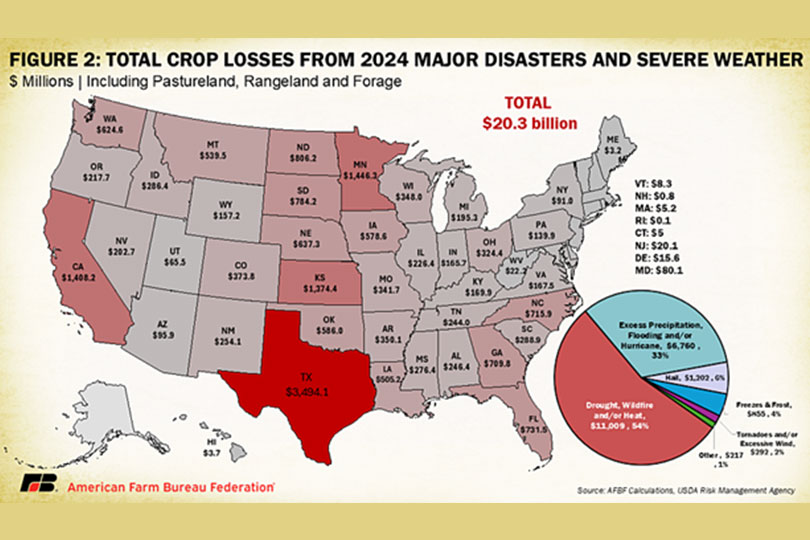By Emmy Powell
Communications Specialist
For the third year in a row, Texas led the nation with the most significant agricultural losses related to weather.
“This isn’t the category Texas wants to take the lead in,” said Brant Wilbourn, Texas Farm Bureau associate director of Commodity and Regulatory Activities. “Farmers and ranchers know that weather-associated production risk is a part of life, but 2024 was another particularly challenging year with damages from wildfires, drought and hurricanes.”
The data, which is pulled from a National Oceanic and Atmospheric Administration (NOAA) report, shows the total incurred damages in Texas was over $3.4 billion.
Drought and excessive heat contributed to more than 66% of Texas’ losses. The most severe drought impacts occurred between June and September.
Texas cotton farmers saw $1.8 billion in losses, and there was a loss of $768 million in forage and rangeland damage and $257 million in wheat losses from drought.
Early in 2024, the Smokehouse Creek Fire caused $123 million in losses, according to Texas A&M AgriLife Extension Service. It was the largest wildfire in Texas and burned more than 1.2 million of acres in the Panhandle.
The 2024 hurricane season was one of the most destructive in U.S. history, with severe consequences for farmers, rural communities and agricultural supply chains.
The report shows hurricane season, which included Hurricane Beryl, caused $227 million in cotton losses, $108 million in corn losses and $91 million in rice losses in Texas.
Last year was the fourth costliest year on record for the U.S. with about $182.7 billion in total losses and damages.
The U.S. experienced 27 weather disasters, each with damages exceeding $1 billion.
According to an American Farm Bureau Federation (AFBF) Market Intel analysis, U.S. farmers lost $20.3 billion to weather disasters in 2024.
“For the past three years, farmers have faced billions in uncovered losses due to natural disasters, highlighting critical gaps in federal disaster relief,” the economists wrote.
Of the billions lost in the U.S. to disaster, $10.9 billion were covered by Risk Management Agency (RMA) programs as of February 2024. About $9.4 billion remained uninsured, fell outside policy coverage limits or did not qualify.
However, funds from the American Relief Act of 2025, which was passed in late December 2024, will be available soon for farmers. The funding is intended to cover losses of revenue, quality and production for crops, as well as losses to trees, bushes and vines caused by disasters in 2023 and 2024.
“This funding provides critical relief for farmers facing financial strain, but it’s only a temporary fix,” Wilbourn said. “What farmers really need is a modernized farm bill that addresses weather disasters, market volatility and rising input costs and the many challenges shaping today’s agricultural landscape.”


Leave A Comment